US job fears keep the Fed dollars flowing


The Fed said it would continue buying bonds at the pace of $85 billion (£53bn) a month until it saw firmer evidence that the world’s biggest economy could come out of intensive care – especially in terms of employment.
Chairman Ben Bernanke said: “Conditions in the job market today are still far from what all of us would like to see.”
Advertisement
Hide AdAdvertisement
Hide AdMarkets had long been pricing in a so-called “taper” of American quantitative easing in September and the Standard & Poor’s 500 index jumped to record levels at the prospect of the money presses rolling on at full speed for at least another month, closing up 1.21 per cent.
The move follows the recent pattern of “bad news is good” which has seen equity markets rally after poor economic figures, which are seen to increase the prospect of long-term stimulus.
After signs of strong growth earlier in the summer, economic data from the US has been notably softer in recent weeks and the Fed downgraded its forecasts accordingly.
The rate-setting Federal open market committee (FOMC) made it clear they were still mulling exactly when to ratchet back their bond-buying, but also reinforced guidance that interest rates will remain at unprecedented low levels as long as unemployment remains above 6.5 per cent. The US jobless rate in August was 7.3 per cent.
The Fed said: “The committee decided to await more evidence that progress will be sustained before adjusting the pace of its purchases. The tightening of financial conditions observed in recent months, if sustained, could slow the pace of improvement in the economy and labour market.”
Central bankers were also worried that market interest rates had been rising since talk of a taper emerged in the spring. Average long-term mortgage rates in the US have risen by a full percentage point since May, jeopardising the fledgling recovery in the housing market.
In a new set of quarterly forecasts, the Fed now sees growth in a 2 to 2.3 per cent range this year, down from 2.3 to 2.6 per cent in its June estimates. The downgrade for next year was even sharper, to 2.9 to 3.1 per cent from 3 to 3.5 per cent.
Most policymakers, 12 out of 17, also projected the first hike in overnight interest rates would not come until 2015, even though forecasts suggested they would likely hit their threshold for considering a rate hike as early as next year.
Advertisement
Hide AdAdvertisement
Hide AdJeremy Cook, chief economist at foreign exchange company World First, said it now looked like tapering may not start until next year. “This is not what the market expected and the Fed has shown its hand that all is not well in the United States,” he said. “It always struck me as strange that the Fed would decide to cut stimulus whilst also cutting growth expectations. If I was an FOMC member I would say no to tapering until 2014.”
Greg McBride, senior financial analyst at Bankrate.com, said: “We’re in a slow-growth economy with high unemployment and low inflation. There’s no specific catalyst for the Fed to remove stimulus.”